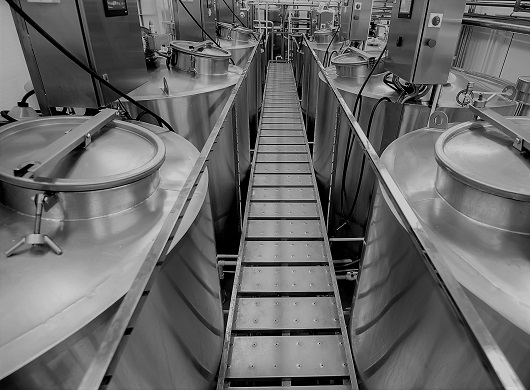
The factory of the future will have only two employees; a man and a dog
“The factory of the future will have only two employees, a man and a dog. The man will be there to feed the dog. The dog will be there to keep the man from touching the equipment” – Warren G. Bennis.
Digitisation, the link between machine and internet is an extremely important Game-Changer. The previous separation between the “real” world of (production) machines and the “virtual” world of the Internet is increasingly being lifted.
Digital and information technologies permeate classic industrial production and manufacturing technologies. In the future, physical and digital worlds will integrate more and more and merge into complex cyber-physical systems.
The next factory will be a human-friendly and robot-friendly factory. It becomes a place of knowledge and knowledge creation. That’s why the factory is evolving into a communication platform for operations. More and more developed automation increases flexibility and makes people a sovereign player again.
The high degree of automation of the factory of the future will mean that in the future, humans will be even more supported by machines in production during monotonous or physically demanding activities. The requirements will shift more to the areas of control, planning, maintenance and process control – Image a factory with no people inside and a NASA like control centre.
The tasks of traditional knowledge and production work will grow closer together, offer new opportunities, but also require a lot of creativity and new qualification profiles. The factory becomes a place of learning, which shows the knowledge in its application and at the same time constantly questioning it anew. The factory becomes a learning ground for employees and requires upskilling of the workforce to work alongside the new technology. To reach this end-state will take time and is not expected to be a revolution as such and mere an evolution over time.
Flexible manufacturing technologies are bringing customer orders and production closer together. In addition to executing in-house work orders and procedures, increasing communication of the factory occurs outside. In the consumer goods sector, the hierarchical supply chains are replaced by global production networks, which need to be coordinated in a timely manner. The factory is going from a commander receiver to the place of cooperation with suppliers and customers. In addition to the classic goals of increasing productivity and minimizing costs, flexible production and cooperative innovation occur.
The next factory allows for smarter layouts and flows, a high degree of flexibility of the factory footprint, for production facilities, including their adaptations and additions. Material streams are organized on mobile transport units. Movement that is repetitive and simple is where to look for the automation options. Have you ever done a walk through your factory and warehouse to identify opportunities for automation or digitisation?
Robots are becoming cheaper and even more flexible in their applications. In addition, industrial robots acquire skills that have been developed so far for the service sector, such as those for communication, or for the automotive industry. Mobility is also increasing, allowing robots to accompany industrial champions and help them with serious and dangerous tasks. Robots are far more flexible because they can be reprogrammed and be given a new purpose, whereas a case packer can only pack cases.
As a strategic principle we should adopt an evolutionary process of change and can consider technological advances such as visuals and electronic notice boards, goggles where they overlay the machine for Engineers on preventative maintenance tasks or for operators on setup and change-over activities. Implementing radio-frequency identification (RFID) tags or smart labels to track materials and know where the next ingredients are is another example for digitisation.
The era of the air-polluting, noisy and energy-eating factory is a thing of the past. The next factory supplies itself. It is determined by the sustainable use of resources and energy. The use of wind power, solar energy, geothermal energy and the production of biomass are the key: The factory is also a power plant, it feeds excess energy into the city network and functions as a buffer in high-energy times. These measures are complemented by closed cycles of water management.
Mere waiting and doing nothing is not adequate, the acceptance of incumbent and/or wrong practices is also not conceivable. In many cases, the strengthening and revitalization of the manufacturing base is the best response to unstoppable new technology and industry disruptors.
As a matter of principle, we need more technology, not less, if we are to preserve the future viability of our manufacturing footprint in Australia.
In the future, the comprehensive digitisation of production will enable all production-relevant factors (human production, machinery, workpieces, plants, suppliers and customers, products and logistics) to be actively involved in the production process and Communicate with each other via smart grids. As a result, the internet takes on a new dimension, industrial production without the use of the Internet is no longer conceivable. The question of which side will be in the “lead” in this merger of the machine and the grid is far from settled, the change has only just begun.
Stephan Mang; Director – Pollen Consulting Group
First published in Inside FMCG:
https://insidefmcg.com.au/2019/04/11/2019-pollen-report/